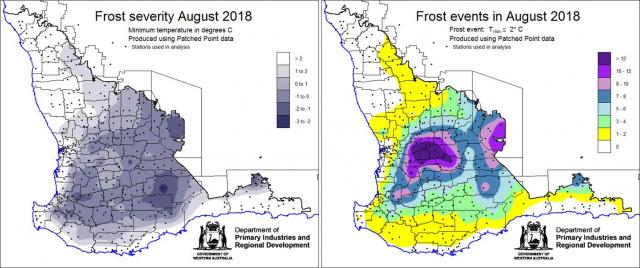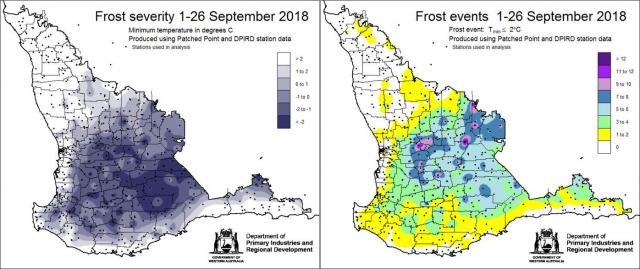Hay or Harvest? Informed salvage options can minimise the impact of frost.
Frost has a significant economic and emotional impact on the whole community and is difficult to manage
A good understanding of the extent of damage after a frost event will help inform salvage options and minimise the impact on the following season.
August and September saw a series of frost events ranging from mild to moderate throughout the central, eastern and southern Wheatbelt (see Figures 1 and 2). Damage in cereals, canola and pulses is now being reported as a result of the most recent frost events that occurred on 15-16 September. Frost susceptible parts of the landscape, gullies, valley floors, light soils and early sown crops are where the majority of losses have been seen so far.
Once a comprehensive assessment has been done, and damage has reached significant levels some growers have taken the opportunity to cut for hay. Options such as the production of hay/silage, grazing, swathing into windrows or hay freezing can be considered, but will depend on the severity, area affected and other compatible farm enterprises (for example, livestock).
Growers should be confident about damage levels and consider all economic aspects before making decisions about damaged crops. Refer to the new Frost Identification Guide for Cereals to help quantify damage.
Most growers will opt to leave the crop and harvest as per usual, perhaps leaving it to harvest last if logistics allow it. Some considerations around this include:
- Frosted crops are difficult to thresh due to higher residual sugars, lower grain volume and green material in the case of a plant re-tillering. Despite lower tonnages, daily harvest maintenance and regular clean down will remain vital to minimise machinery fatigue and fire risk in these difficult harvesting conditions.
- Grain quality may also be compromised depending on the frost timing. Frost affected grains usually have a lower hectolitre weight and higher screenings. Adjusting header settings and/or grading can be beneficial but check the feasibility first.
If cutting for hay, timing is everything. Previous DPIRD case studies have shown little difference in crude protein and dry matter digestibility in frosted verses non frosted cereals, with time of cutting having a greater influence on hay quality.
In cereals, straw quality declines after early grain-fill / milk dough period. Later stage of maturity usually results in higher fibre, lower protein and energy content. If the frost was severe leaf damage may be evident. In this case cutting as soon as possible helps preserve the colour thus minimising quality deterioration.
Consider the demand and opportunity for marketing hay, the potential for on-farm storage and use of hay from the frosted crop and the likely costs and returns from haymaking. Hay quality can vary greatly, quality testing is suggested before feeding to livestock. Depending on soil moisture the plant may re-tiller and grain can be harvested.
Other considerations include:
| Advantages | Disadvantages |
| Stubble removed | Cost per hectare |
| Weed control | Quality may be poor depending on frost timing and opportunity to cut |
| Recover costs |
|
The table below outlines the advantages and disadvantages of other cost recovery options.
| Options | Advantages | Disadvantages | Considerations |
| Chain / rake | Retains some stubble and reduces erosion risk
Allows better stubble handling at seeding | Cost per hectare
Time taken | Consider weed burden, wind and water erosion. |
| Graze | Good feed value depending on frost timing
Weed control | Inadequate stock to utilise feed - stock feed unevenly
Remaining grain may cause acidosis
Stubble may be difficult to sow into | The feed value will vary depending on crop type. Frosted pulse crops will have minimal grain present, so can't be considered ideal for finishing livestock. |
| Hay freezing / spray | Stops weed seed set
Preserves feed quality for grazing
Gives time for decisions
Retains feed
Retains organic matter | Difficulty getting chemicals onto all of the weeds with a thick crop
May not be as effective as burning
Boom height limitation
Cost per hectare
Some grain still in crop | Hay freezing the damaged crop before grazing will maximise the fodder quality and rotation benefit.
|
| Plough | Recycles nutrients and retains organic matter
Stops weed seed set
Green manure effect | Requires offset discs to cut straw
Soil moisture needed for breakdown and incorporation of stubble | It will depend on the rotation option planned for next year. A pasture option has different requirements to a crop option where stubble must be prepared. |
| Swath | Stops weed seed set
Windrow can be baled
Regrowth can be grazed
Weed regrowth can be sprayed
Can preserve some of the nutritive value of the crop without the expense of applying desiccant herbicides | Relocation of nutrients to windrow
Low market value for straw
Poor weed control under swath
Cost per hectare | More suited to lighter textured soils where erosion may pose a problem for green manuring.
|
| Burn | Recycles some nutrients
Controls surface weed seeds | Potential soil and nutrient losses
Fire hazard | Consider wind and water erosion risk.
Particularly if grazing will occur before burning. |
For information on frost identification in crops, assessment and management options refer the article ‘Frost resources available to assist growers’ or visit one of the pages below:
- Frost Identification Guide for Cereals
- Management options for a frost crop
- Frost: Frequently Asked Questions brochure
- Frost monitoring tips
- Minimum temperatures from DAFWA weather stations can be viewed and exported from the Extreme weather events page and Weather Station app.
Growers and consultants are encouraged to make reports of any frost events in their local areas using the PestFax Reporter app. These reports will appear on the PestFax map.
For more information contact Kelly Ryan, development officer, 9368 3480 or Ben Biddulph, research officer, on 9368 3431.


